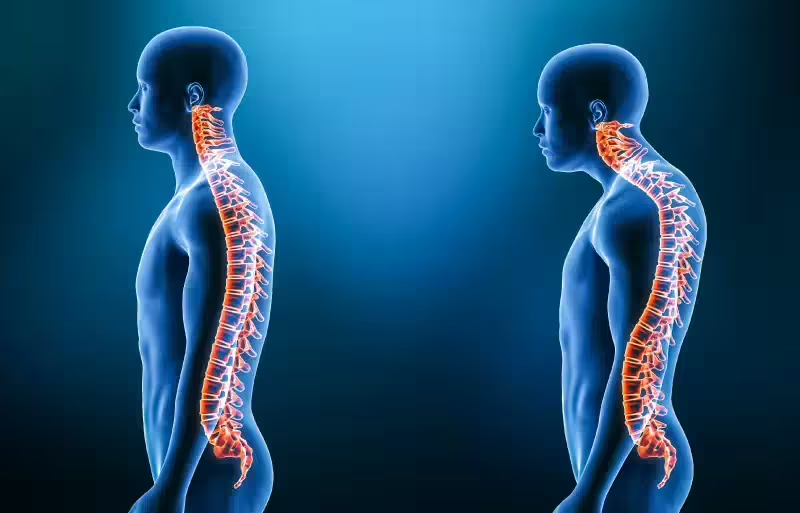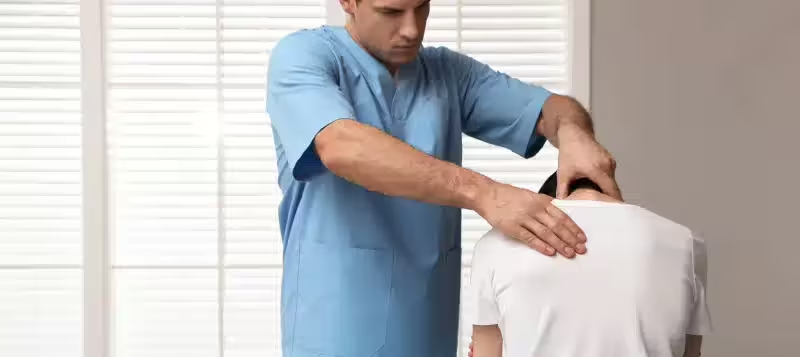Do you have a strong curvature of the spine or neck? This can result in many symptoms, both short- and long-term. The chiropractor’s care can provide relief. We always start with the examination, but the cause of the curvature. Because in the cause, also lies the key to recovery.
You can read more about this on this page.

What exactly is kyphosis?
The base of the back and neck is formed by the spine, an accumulation of all kinds of vertebrae. We speak of kyphosis when there is a strong forward curvature in the spine. A kyphosis in the upper back is also called thoracic kyphosis. This is because the curvature is at the level of the thoracic vertebrae. For the same reason, kyphosis in the neck is also called cervical kyphosis.
The upper back and neck are supposed to be slightly curved, but in the case of kyphosis, there is a more severe curvature and it can be easily seen as a kind of kink in the back or neck. Also, the head and shoulders are often more forward.
The causes of kyphosis
There are many possible causes for this condition. The spine is surrounded by vastly different structures. When these structures become unbalanced, kyphosis can occur. Some of the possible causes for this will be explained below.
Poor posture: Poor posture can cause the structures around the spine, such as muscles and ligaments, to stretch. As a result, they can no longer properly perform their function of providing stability to the spine. It is then possible for back or cervical vertebrae to sag, causing kyphosis.
Muscle weakness: Muscle weakness, due to a nerve or muscle disorder, for example, can also result in kyphosis. Weaker muscles may not provide enough support to the back or neck, causing it to sag.
Osteoporosis: Osteoporosis is a natural aging process. In a normal situation, as much bone is created as is broken down. As you age, bone degradation accelerates faster than bone production. This process is also known as osteoporosis. This decalcification causes the bones to become less strong. As a result, they can deform or break more easily and cause kyphosis.
Other causes: As mentioned, kyphosis can have several causesben. Some of these have already been mentioned. However, this condition can also result from a change in the intervertebral discs, Bechterew’s disease, growth disorders, wear and tear on the spine, cancer or an infection or damage to the vertebrae.
Common complaints with kyphosis
The main complaint of kyphosis is pain around the site of the curvature. In addition, people with kyphosis often suffer from fatigue and muscle pain due to the constant correction of posture. There may also be headaches and difficulty maintaining balance. With severe kyphosis, respiratory problems may occur.

How can a chiropractor help me with symptoms due to kyphosis?
Chiropractic focuses on restoring balance between the spine and nerves. The chiropractor does this through manual pressure techniques. These techniques can cause structures to be less pinched, reducing symptoms.
Before the chiropractor begins treatment, there will first be an introductory meeting in which the complaints are discussed. In addition, the chiropractor conducts physical examinations to determine the cause of your symptoms.
Once the chiropractor knows more about the underlying cause of the kyphosis, an appropriate treatment plan can be developed. This treatment aims to reduce your symptoms and prevent the symptoms in the future.
Exercises for kyphosis in the back or neck
In addition to manual pressure techniques, the chiropractor’s treatment may include teaching you exercises that are beneficial to your kyphosis. The exercises help strengthen muscles and keep you mobile in the back or neck. Some examples of exercises that can help reduce symptoms due to kyphosis are:
- Stand or sit in as straight a position as possible and gently move your chin back, without moving the chin up or down. Repeat several times.
- Stand or sit in as straight a posture as possible and move the shoulders back and down. Herhaal dit verschillende keren.
- Lie on your stomach with the arms along the upper body. Lift your head, chest and shoulder blades off the ground and face the ground. Repeat this several times.
The chiropractors can help you choose the best exercises to reduce your symptoms.
